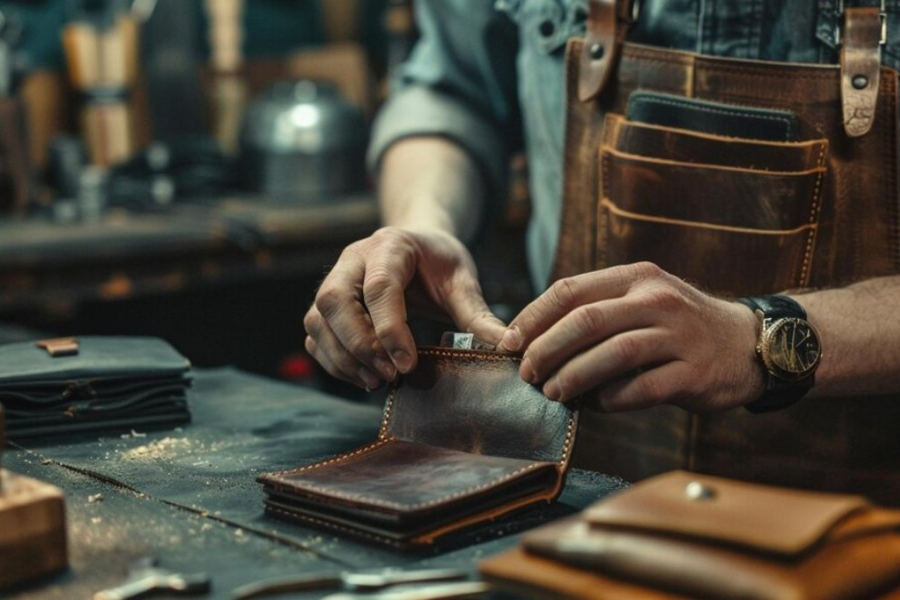In a world dominated by mass production and digital innovation, the art of crafting by hand holds a unique allure. Leatheling, the ancient craft of leatherworking, is experiencing a modern renaissance, captivating both artisans and enthusiasts.
This blog delves into the rich history, techniques, and community that make leatherwork a timeless and evolving art form. Whether you’re a seasoned craftsman or a curious beginner, immersing yourself in this craft can be incredibly rewarding.
The Ancient Roots of Leatheling
Leatheling dates back thousands of years, with evidence of leatherworking found in ancient civilizations. From the simple leather sandals of the Egyptians to the intricate armor of the Romans, leather has been a staple material due to its durability and versatility. Across cultures, it has been utilized for clothing, shelter, tools, and art. The ancient significance of leatherwork lies in its ability to adapt to various needs and environments, showcasing the ingenuity of early artisans.
Techniques in leatherworking have evolved over millennia, yet the essence of the craft remains unchanged. The tanning process, which transforms raw hides into supple leather, is a skill passed down through generations. Traditional methods, such as vegetable tanning using natural tannins, are still valued today for their sustainability and superior quality. This deep connection between past and present solidifies leatherwork as a timeless craft.
The Revival of Leatheling
In recent years, there has been a resurgence of interest in traditional crafts, and leatherworking is no exception. This revival is driven by a growing appreciation for handmade and sustainable products. In a world dominated by fast fashion, consumers increasingly seek unique items that tell a story. Leatheling offers a tangible connection to history and a means of expressing creativity.
Today’s artisans are blending age-old techniques with modern aesthetics to create stunning leather goods. From bespoke footwear to handmade bags, the possibilities are endless. This fusion of tradition and innovation has reinvigorated leatherworking, attracting a diverse community of makers eager to refine their skills. The craft’s versatility allows artisans to explore their personal style while honoring the techniques of their predecessors.
The Art of Intricate Leatheling Designs
One of the most captivating aspects of leatherworking is the potential for intricate design. Skilled artisans can transform a simple piece of leather into a work of art using techniques such as embossing, carving, and stitching. These methods require precision and patience, but the results are breathtaking. Each piece tells a story, reflecting the artist’s vision and skill.
Creating complex designs begins with selecting the right leather. Different types of leather have unique textures and properties that influence the design process. For instance, vegetable-tanned leather is often preferred for its ability to hold detailed carvings, while softer leathers are ideal for smooth, flowing patterns. Once the leather is chosen, artisans utilize various tools to bring their designs to life, carefully considering every detail.
The Functional Beauty of Leatheling
Beyond its aesthetic appeal, leatherwork serves practical purposes. Leather goods are valued for their durability and longevity, making them perfect for everyday use. From sturdy belts to protective wallets, these items are designed to withstand the test of time. In a culture that often favors disposability, investing in quality leather products is a sustainable choice.
Leatherworking allows artisans to create functional items that are as beautiful as they are practical. This duality is part of what makes the craft so engaging. Each piece is meticulously crafted, whether it’s a finely stitched briefcase or custom-fit shoes. This attention to detail ensures that leather products not only look great but also perform their intended purpose effectively.
Sustainable Leatheling Practices
In an era of environmental awareness, many leather artisans are adopting sustainable practices. This includes using eco-friendly materials, such as vegetable-tanned leather, and minimizing waste through efficient production methods. By prioritizing sustainability, artisans contribute to a more responsible and ethical approach to leatherworking.
Sustainable practices extend beyond material choice. Artisans are also exploring ways to repurpose and recycle leather scraps, reducing their environmental footprint. This commitment to sustainability aligns with the broader movement toward conscious consumerism, where individuals seek products that reflect their values and respect the planet.
Leatheling Communities and Connections
Leatheling is not just an individual pursuit; it fosters a vibrant community of makers and enthusiasts. This sense of camaraderie is evident in numerous workshops, online forums, and social media groups dedicated to the craft. These platforms enable artisans to share knowledge, collaborate on projects, and celebrate each other’s successes.
The leatherworking community is welcoming to individuals of all skill levels. Whether you’re a novice eager to learn the basics or an experienced artisan looking to refine your techniques, there’s always room for growth and exploration. This spirit of collaboration and support makes the leatherworking community unique, encouraging individuals to continue honing their craft and sharing their passion.
Preserving Traditional Leatheling Techniques
Amidst the modern revival of leatherworking, artisans are dedicated to preserving traditional techniques. These craftsmen understand the importance of maintaining cultural heritage and passing knowledge to future generations. By keeping these techniques alive, they ensure that the art of leatherwork remains rich and diverse.
Preserving traditional methods involves more than just replicating age-old practices. It requires a deep understanding of the cultural context and significance behind each technique. By honoring their traditions, artisans pay homage to those who came before them, ensuring that future generations can continue to enjoy and learn from this legacy.
Leatheling in the Modern World
While leatherworking has deep historical roots, it finds its place in the modern world. Contemporary designers are incorporating leather into innovative and unexpected creations, pushing the boundaries of the craft. This blend of tradition and modernity has led to unique pieces that challenge conventional notions of leather.
The versatility of leather makes it an excellent canvas for experimentation. From avant-garde fashion pieces to contemporary furniture designs, leatherworking offers limitless possibilities for modern expression. This willingness to explore new frontiers ensures that the craft remains relevant and exciting, appealing to a broad audience of makers and enthusiasts.
The Future of Leatheling
As the world continues to evolve, so too will the art of leatherworking. With advancements in technology and a growing emphasis on sustainability, the future of leatherworking is poised to be both innovative and responsible. Artisans are exploring ways to integrate modern tools and techniques while preserving the integrity of traditional craftsmanship.
This forward-thinking approach ensures that leatherworking will remain at the forefront of the artisanal world. By balancing innovation with tradition, artisans can push the boundaries of what’s possible, creating pieces that captivate and inspire. The future of leatherworking is bright, with endless opportunities for growth and exploration.
How to Begin Your Leatheling Journey
For those inspired to dive into leatherworking, getting started is easier than you might think. Begin by gathering basic tools and materials, including leather, needles, and thread. Numerous resources are available online and in local communities to assist beginners through the initial steps of the craft.
Start with simple projects like keychains or small pouches to build confidence and develop essential skills. As you become more comfortable with the techniques, gradually progress to more complex designs. Remember, leatherworking is a journey that rewards patience and persistence, offering endless opportunities for creativity and self-expression.
Conclusion
Leatheling is a craft that transcends time, merging the artistry of ancient techniques with the creativity of modern innovation. Its enduring appeal lies in its ability to connect us to our past while providing countless opportunities for the future.
Whether you are drawn to the beauty of intricate designs or the practicality of durable leather goods, leatherworking invites you to explore a world rich in creativity and craftsmanship.
Stay ahead with exclusive insights and breaking news on the dgmnews.


